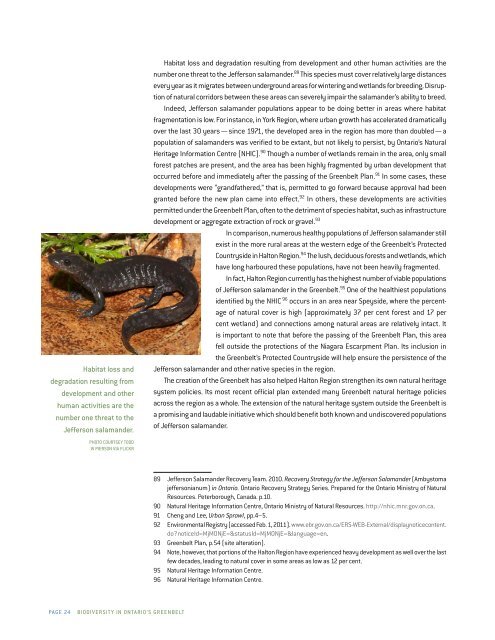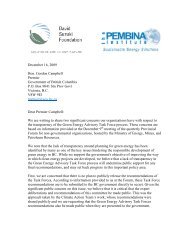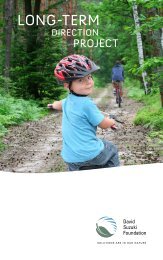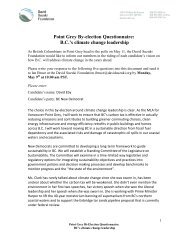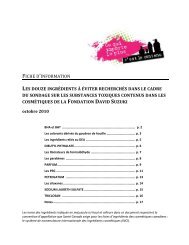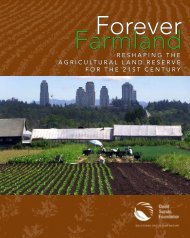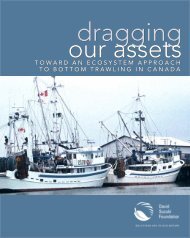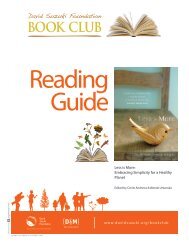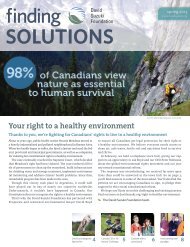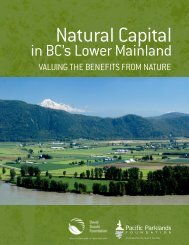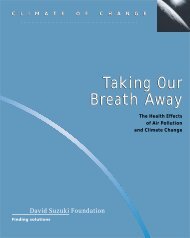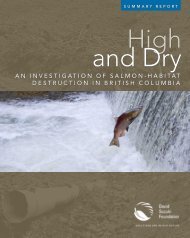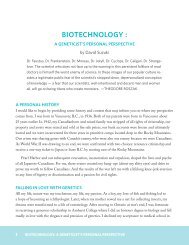Biodiversity in Ontario's Greenbelt (PDF) - David Suzuki Foundation
Biodiversity in Ontario's Greenbelt (PDF) - David Suzuki Foundation
Biodiversity in Ontario's Greenbelt (PDF) - David Suzuki Foundation
You also want an ePaper? Increase the reach of your titles
YUMPU automatically turns print PDFs into web optimized ePapers that Google loves.
Habitat loss and<br />
degradation result<strong>in</strong>g from<br />
development and other<br />
human activities are the<br />
number one threat to the<br />
Jefferson salamander.<br />
photo courtsey Todd<br />
W Pierson via flickr<br />
Habitat loss and degradation result<strong>in</strong>g from development and other human activities are the<br />
number one threat to the Jefferson salamander. 89 This species must cover relatively large distances<br />
every year as it migrates between underground areas for w<strong>in</strong>ter<strong>in</strong>g and wetlands for breed<strong>in</strong>g. Disruption<br />
of natural corridors between these areas can severely impair the salamander’s ability to breed.<br />
Indeed, Jefferson salamander populations appear to be do<strong>in</strong>g better <strong>in</strong> areas where habitat<br />
fragmentation is low. For <strong>in</strong>stance, <strong>in</strong> York Region, where urban growth has accelerated dramatically<br />
over the last 30 years — s<strong>in</strong>ce 1971, the developed area <strong>in</strong> the region has more than doubled — a<br />
population of salamanders was verified to be extant, but not likely to persist, by Ontario’s Natural<br />
Heritage Information Centre (NHIC). 90 Though a number of wetlands rema<strong>in</strong> <strong>in</strong> the area, only small<br />
forest patches are present, and the area has been highly fragmented by urban development that<br />
occurred before and immediately after the pass<strong>in</strong>g of the <strong>Greenbelt</strong> Plan. 91 In some cases, these<br />
developments were “grandfathered,” that is, permitted to go forward because approval had been<br />
granted before the new plan came <strong>in</strong>to effect. 92 In others, these developments are activities<br />
permitted under the <strong>Greenbelt</strong> Plan, often to the detriment of species habitat, such as <strong>in</strong>frastructure<br />
development or aggregate extraction of rock or gravel. 93<br />
In comparison, numerous healthy populations of Jefferson salamander still<br />
exist <strong>in</strong> the more rural areas at the western edge of the <strong>Greenbelt</strong>’s Protected<br />
Countryside <strong>in</strong> Halton Region. 94 The lush, deciduous forests and wetlands, which<br />
have long harboured these populations, have not been heavily fragmented.<br />
In fact, Halton Region currently has the highest number of viable populations<br />
of Jefferson salamander <strong>in</strong> the <strong>Greenbelt</strong>. 95 One of the healthiest populations<br />
identified by the NHIC 96 occurs <strong>in</strong> an area near Speyside, where the percentage<br />
of natural cover is high (approximately 37 per cent forest and 17 per<br />
cent wetland) and connections among natural areas are relatively <strong>in</strong>tact. It<br />
is important to note that before the pass<strong>in</strong>g of the <strong>Greenbelt</strong> Plan, this area<br />
fell outside the protections of the Niagara Escarpment Plan. Its <strong>in</strong>clusion <strong>in</strong><br />
the <strong>Greenbelt</strong>’s Protected Countryside will help ensure the persistence of the<br />
Jefferson salamander and other native species <strong>in</strong> the region.<br />
The creation of the <strong>Greenbelt</strong> has also helped Halton Region strengthen its own natural heritage<br />
system policies. Its most recent official plan extended many <strong>Greenbelt</strong> natural heritage policies<br />
across the region as a whole. The extension of the natural heritage system outside the <strong>Greenbelt</strong> is<br />
a promis<strong>in</strong>g and laudable <strong>in</strong>itiative which should benefit both known and undiscovered populations<br />
of Jefferson salamander.<br />
89 Jefferson Salamander Recovery Team. 2010. Recovery Strategy for the Jefferson Salamander (Ambystoma<br />
jeffersonianum) <strong>in</strong> Ontario. Ontario Recovery Strategy Series. Prepared for the Ontario M<strong>in</strong>istry of Natural<br />
Resources. Peterborough, Canada. p.10.<br />
90 Natural Heritage Information Centre, Ontario M<strong>in</strong>istry of Natural Resources. http://nhic.mnr.gov.on.ca.<br />
91 Cheng and Lee, Urban Sprawl, pp.4–5.<br />
92 Environmental Registry (accessed Feb. 1, 2011). www.ebr.gov.on.ca/ERS-WEB-External/displaynoticecontent.<br />
donoticeId=MjM0NjE=&statusId=MjM0NjE=&language=en.<br />
93 <strong>Greenbelt</strong> Plan, p.54 (site alteration).<br />
94 Note, however, that portions of the Halton Region have experienced heavy development as well over the last<br />
few decades, lead<strong>in</strong>g to natural cover <strong>in</strong> some areas as low as 12 per cent.<br />
95 Natural Heritage Information Centre.<br />
96 Natural Heritage Information Centre.<br />
Page 24<br />
<strong>Biodiversity</strong> <strong>in</strong> Ontario’s greenbelt


